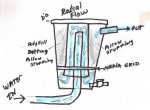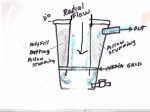I have been showing restraint, but I give..

Will share my thoughts, but not going to argue. If folk want to believe their filter system cure all ailments that exist in the pond world, then that is a fair enough positioning to me.

In regards to self-cleaning sieves, I have not yet seen a single sieve that is truely self cleaning. They all require assistance at dumping the debris, including the cetus sieve. The only truely self-cleaning mechanical filter I have seen are the
rotary drum filters (RDFs) and the only maintenance on these are to make sure the sprayers do not get clogged over time with mineral buildup, which mineral buildup might not occur depending on pond's water chemistry. However, a properly built RDF is quite expensive starting at around $2,500 US for a unit that can handle 3,900 gph.
I like the
radial flow settlement chamber due to it taking less space than a true vortex settlement chamber. Also, could construct the vortex to take less space by building it to have a type of
pre-filter inside the vortex. To make a true vortex type settlement chamber, without modifications, then the chamber tank size must be 10% of the flow rate; so, 1,000 gph would require a 100 gallon chamber to properly slow down the water so to allow the debris to properly settle down in the tank.
S&Gs (
sand and gravel filter) are very awesome polishing mechanical filtration. Although, I have seen these used as the only mechanical filtration, which will needed to be blown out more often, but they have to be flushed quite a bit. S&Gs will also contribute to a particular environment to help with bio-filtering. There are quite a few youtube videos that show how they are blown out. The depth of each differently sized rock layer inside the filter is what determines the filter's flow rate and how hard the filter can be blown. S&Gs are essentially a
controlled, purging version of a bog. Plants can be put on top if so desired.
For a simple pad mechanical filter, you could get a 5 gallon bucket with a
gamma seal lid and fill it with various sized matala filter pads. There is a gasket on this seal lid and it screws down quite tight on the bucket so to make a water tight seal and can withstand water pressure from within without busting the lid off. If built so to create a water lock that can be primed after cleaning, then you could place this type of filter as a pre-filter prior to your pump; although, this could significantly increase your pump's head height demands depending on volume and sizing of padding in it.
For bio-filtration, I enjoy the moving bed filter and using plants throughout my pond's stream. I chose the moving bed filter since it helps to release the dissolved gases in the water and does not oxidize much nitrogen out of the water, such as shower towers, since I want this nitrogen for my plants. Trickle towers and skippies and static submerge bio-filters are fine, but I believe and have seen their bio-filtering processing capability to be lower. Bogs are fine as well, but, when I do construct one, I would rather it be one built to be an aquaponic grow bed such as one for a vegetable garden.
Here is how I have mine setup... I put in a little over $2,000 into it. Most of the investment, around about 90% of it, is in the mechanical filtration since I think mechanical filtration is the most important and significantly improves a bio-filters efficiency.
Running around 4,300 gph through my itsy-bitsy 435 gallon pond.
I am using a suction side sieve, such as the
zakki sieve (which is what I use). However, keep in mind that anything on the suction side of a pump will significantly increase the head height demand on a pump. There aren't many suction side particulate mechanical filtration devices available. The reason these are used on the suction side is so to prevent the debris from getting chopped into finer bits after exiting the pump, which these finer bits are somewhat tougher to capture.
For my retro-fit 2 inch "bottom drain", I simply heated up 3 seperate 10 foot spans of 2" PVC so to make a circle, then used a grinder to cut out 1/2" wide slits and 3/4" wide slits all around it and spaced 1/4" between each slit, then connected it all together around my center fountain, and this is my suction inlet. Strapped on top of my suction inlet is 30 foot length of
colorite aero-tubing so to provide a vertical circular current, which also has helped the floating debris to reach my 2 skimmers on each side of the pond. Sieves are larger particulate filtration. For smaller polishing particulate mechanical filtration, after the pump, then I use a
MC-50 (also called the MC-16). After the polishing filter, a portion of the water is T'd off to go into my
DIY'd moving bed filter and to my growing beds, but, since my grow beds are not setup, then it all goes to my moving bed filter. After the bio-filters, I have a booster pump to push the water into my waterfall and stream. During the winter, I have a bypass in the pond so to continue circulating the water without it going through my filtration and/or stream. This portion of the system totals around 2,300 gph.
My two skimmers each have a 1,000 gph pump. One skimmer sends water to my fountain in the center of the pond and the other skimmer feeds my pond returns to help create a horizontal water current. My four pond returns are simply just 1/2" PVC that standup inside my pond with a smooth 90 elbow and around 250 gallons is pushed through each of them.
I also have my plumbing rigged up so I can divert the water to some growing beds or setup so I can completely bypass all of my filtration during the winter by having all of the water pushed through my pond returns.
This is a retrofit job and I did my best to hide the plumbing with my rock wall, which does catch some debris. So, I have to occasionally, when I see the debris, spray the rocks to knock the debris loose to reach my drain or use my pond vacuum.
All of this is built so to create
water currents to obtain a self cleaning pond, that is designed so the water currents push the debris to the drain and to the skimmers.
It literally only takes me 2~3 minutes total to clean out both of my filters with simple switching on/off of valves and no pads or screens to clean, only clean my skimmer baskets when ever there is a noticeable amount of debris in them, and spray down my rock walls whenever I notice some debris. So, within an entire week, I spend about 10 minutes all together in cleaning my filtration. I have waited up to 3 weeks without cleaning and it never created a problem.
I spend the vast majority of my ponding time with playing evil water chemist on my pond and fish. :salook: Continually pushing my fish stock density.



